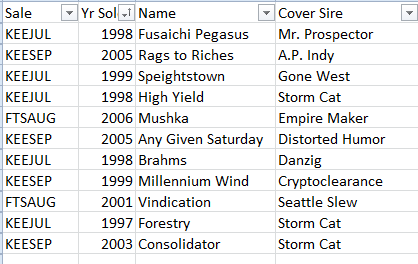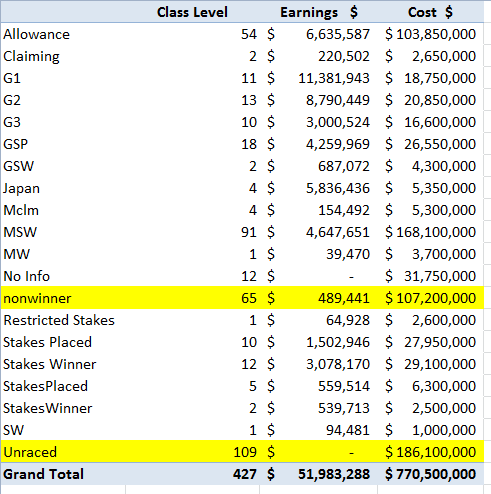The Green Monkey Project was a project born out of a question raised when the high-priced Juvenile “Iron Fist” made his debut at Delmar. Several pundits mentioned they were picking Iron Fist because his purchase price was one point five million dollars.
A comment like this is put in print or in social media and pretty soon it is accepted as fact. When I heard this – I thought to myself – the opposite, over the years it seems like expensive yearlings are busts on the track or never make it to the races.
I then thought it would be sweet to have a list of all the Million Dollar “Babies” and be able to look up how much each earned on the track. This sounded like a simple request and in any other sport this would be accomplished in about 3 minutes. Not in Horse Racing with no central organized database that you can pull data and query results.
Thus the Genesis for my research began and a quest to answer simple question – are high-priced yearlings good bets when they debut?
Project Methodology
Since no central database was available with the immediate information. I had to come up with a list of all horses who were purchased as yearlings in the United States. I chose yearlings – and excluded “2-year-old in training” sales since that is a talent level of horses that is fundamentally different from a high-priced yearling. A high-priced yearling is sold more on pedigree and a top price 2-year-old in training is sold on early development and fast works.
I queried Bloodhorse.com and went to the Auction Page. I downloaded all the yearlings from 1991 through 2011 since those horses are now 3 years old. I then imported all the yearlings who had sold for 1 million dollars and only included horses who had sold for one million dollars or more. Horses who were RNA were not included. this gave me a database of 427 horses.
Once I had a list of horses and their auction prices. I needed data on how much money they had earned, how often they had raced and what they had done on the track. Again for any other sport this would be simple. Not for Horse Racing. So between Lifetime Past Performances I have over the years and from using Equibase – I searched every horse in the data set and typed in Starts, Wins, Earnings, Top Class and Trainer.
Since many of these horses have multiple trainers. I made the trainer who was the trainer of record when the horse made his debut as the “trainer of record” So if for example a horse made his debut trained by Nick Zito in his first lifetime race – then switched to Wesley Ward in career race #2 then officially Nick Zito is listed as trainer. Zito was the trainer who got him to the race track.
Some horses just disappeared, a few horses were never named and over 140 horses I have no information on. Either for trainer or race records.
Disclaimer:
I’m not interested in excuses. I don’t care if these “horses” were purchased with side deals, I’m not interested in stallion deals and that the mares were sold at a profit. They bought these horses to win races. I have never seen someone quoted at a sale as saying “we bought this horse today and he is now retired to be a stallion”. Supposedly the best and brighest of the horse people picked these horse and bought them to race them and the data shows these horses were sold at this price to these people. If you actually add in training costs, vet bills, trainer fees and other expenses these horses are a colossal waste of talent.
The Data
Below is a link for people to upload the data and do their own studies:
https://docs.google.com/spreadsheets/d/1g59oWvZKza2Gf4hsAxPazgOFDJRFWlom8pxQTHIHS8E/edit?usp=sharing
The Bottom Line:
- 427 “Million Dollar Babies” Purchased for 770 Million
- Career earnings of 427 horses – 51.8 Million Dollars
- Lifetime Starts 3,639 starts
- Lifetime Wins – 767
- Lifetime Win % 21
The Few – The Proud – The Grade 1 winners
Out of 427 purchases – 11 achieved Grade 1 Status:
Fusaichi Pegasus and Rags To Riches achieved the ultimate Golden Ring. A Kentucky Derby, Kentucky Oaks or a Classic Winner. Speighstown was champion sprinter and Any Given Saturday won the Haskell.
Overall the 427 horses broke down into the following classifications:
The Ugly:
109 horses went Unraced
65 horses raced and never broke their maiden
67 Horses won 1 Race!
Quick Takes:
- Million Dollar Babies have not been a good investment!
- The ROI is horrible
- The amount of Grade 1 Stakes Winners for the talent level is underperforming
- a large number go unraced for both fillies and colts
- Very few colts became Great Stallions
- They are horrible betting opportunities – low odds and winning percentage is low
In Part 2 of the Green Monkey Project we will take a look at some of the trainers and buyers of these horses and overall record.


